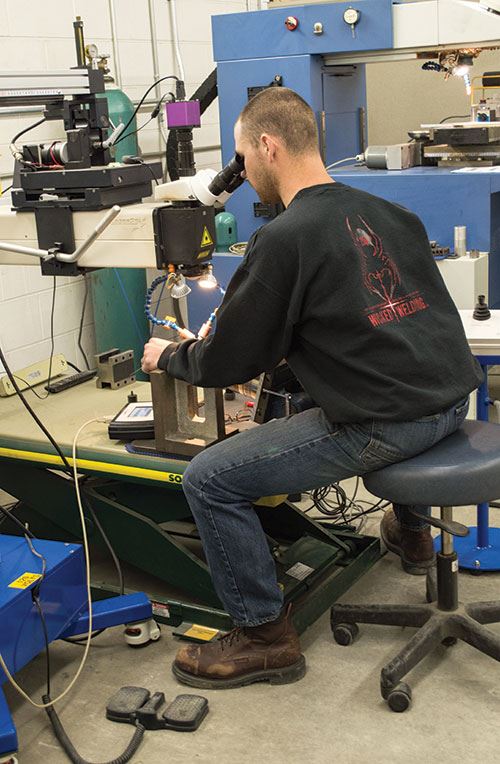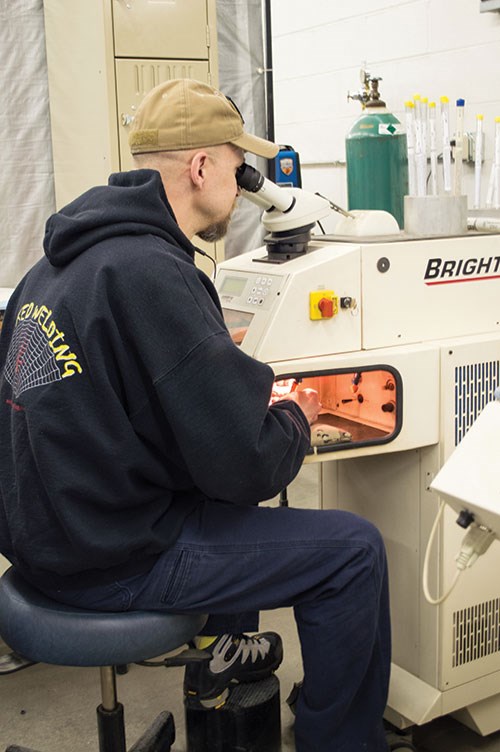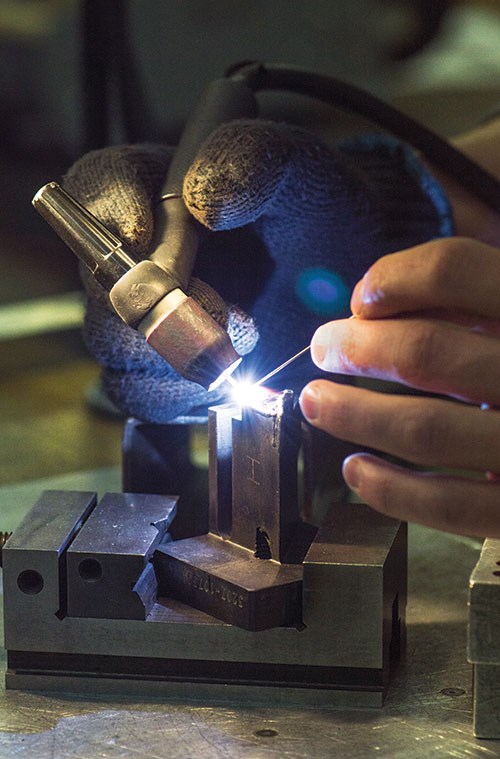An Indispensable Welding Process
Laser equipment is nothing less than essential to performing repairs and engineering changes for this company’s mold-industry customers.
Share
“I realized that no matter how good I got with micro-TIG welding, it’d never be laser.”
That’s how Pete Mourouzis, founder and president of Wicked Welding, describes the first time he ever saw a laser welder in action. Although it took a while for the company to purchase its first laser system, this technology is now nothing less than essential to serving its mostly mold-industry customers, Mourouzis says. The shop’s experience provides a window into not only why laser welding has become so important, but also the advantages of different equipment configurations and where the technology fits with other processes.
Growth by Referral
Occupying a 4,000-square-foot facility in Dayton, Ohio, Wicked Welding got its start in 2002 when Mourouzis, then a welder at a struggling mold shop, decided to strike out on his own. Since then, the business has grown to employ three other welders and a part-time secretary.
The company has done very little to market itself over the years, Mourouzis says. Referrals have proven more than sufficient to attract enough work, about 70 percent of which hails from the mold industry in any given year. Although the company’s reputation deserves much of the credit, this growth also evidences the importance of welding for any manufacturer or user of mold tooling.
Within a few years after the company’s founding, however, Mourouzis and his team realized that TIG and micro-TIG would no longer be enough. In 2006, the company purchased its first laser system, a 1900 series machine from Riverside, Rhode Island-based LaserStar Technologies. Subsequent years would see the shop further expand laser capacity with the addition of larger, more automated models, such as LaserStar’s 7700 series. Today, laser equipment is employed for approximately 35 percent of all work at Wicked Welding, and all indications are that this figure will continue to increase, Mourouzis says.
An Essential Process
Whether for repairing worn areas, accommodating engineering changes or fixing mistakes, laser enables mold adjustments that would be either impossible or far more difficult with other welding technologies, he explains. That’s primarily due to the processes’ extreme precision. Wicked Welding’s 7700 series machine, for instance, can lay beads as small as 0.0025 inch. That precision, in turn, can be credited largely to a second benefit of laser welding: minimal transfer of heat to the surrounding workpiece material.
In contrast to the light emitted by a pulsed, ND:Yag laser, TIG and micro-TIG processes use electric current to create the heat needed to bind the filler rod to the workpiece material. The problem is that this current imparts comparatively more heat into the areas surrounding the weld, Mourouzis says. These areas of the workpiece can distort, resulting in a phenomenon commonly known as “sink.” Compensating for this distortion often requires additional welding, which, in turn, leads to additional time spent removing extra material via hand-grinding or even milling. In addition to saving time on these operations, minimal heat radiation often eliminates the need to preheat tool steel, a step that’s often required to prevent TIG processes from cracking the work.
Wicked Welding’s largest, most powerful laser, the 7700 series machine, offers beam-enhancement resonator technology that is said to amplify these benefits. Known as Soft Touch, this feature is designed to limit thermal lensing, or the tendency of the center of a laser beam to be hotter than the outer regions. Soft Touch creates a softer, more uniform beam profile to avoid the resulting splashed metal, blown holes or damage to heat-sensitive material. This technology contributes to Wicked Welding’s ability to keep sink to only about two tenths (0.0002 inch) in laser welding applications, compared to a thou and a half (0.0015) with micro-TIG and five thou (0.005) with conventional TIG.
He adds that laser is more viable when customers avoid heat-treating entirely, opting instead to finish-machine the mold and nitride it afterwards. “Nothing works perfectly on these jobs,” Mourouzis says. “The material will start to pop and sputter, and you’ll get pits, like the cross section of a Three Musketeers (candy) bar. But laser is usually much better than micro-TIG. You can go over it again and eliminate many of the voids, but if you try to do that with micro-TIG, you’ll just make more holes.”
Configuration Matters
Although all of Wicked Welding’s laser equipment offers essentially the same essential advantages compared to micro-TIG, different systems are better-suited for different jobs. For Mourouzis and crew, this lesson was driven home early with their first laser purchase, the 1900 series LaserStar. Laser technology in general was far more expensive at the time, but in hindsight, that turned out to be a good thing. “I’m actually glad we couldn’t afford a bigger system for our first purchase, because we’d have really missed out on some important benefits of having this smaller model,” Mourouzis says.
Chief among those benefits is speed. Particularly for smaller work, manipulating certain parts by hand can be easier and faster than using various combinations of jigs and fixtures to set them up for a larger, more automated system. At Wicked Welding, one common example is core pin repair. “Say someone uses a sinker EDM to burn the top of a core pin, but the flush isn’t very good. That’ll create a little arc pit down in the bottom of the burn,” Mourouzis explains. “Instead of having to do some kind of setup, we can just hold that pin in the laser, put the filler wire on there, zap it and be done. It literally might be a few-minute process.”
Of course, that machine has its limits. For instance, the ability to create, say, a straight-line weld is dependent entirely on the skill of the operator. In contrast, precision is virtually built into the shop’s larger 7700 series machine, which features a joystick for X- and Y-axis control and a foot pedal for Z-axis control. Instead of manipulating the part, operators can direct their attention to setting the right voltage, power, pulse rate and other parameters for the job.
Although it does require setup, this larger machine is quite versatile in its own right, Mourouzis points out. For one, LaserStar offers various motion control accessories, such as rotary fixtures for shafts and pins. Additionally, the 7700 features a “universal jig”—that is, a gantry-type system that enables swinging the laser head out over the part. In contrast, comparable models often use X- and Y-axis tables to move the part underneath the laser head. “It’s great because we’re not limited by Z height,” he says. “In another laser with a stationary head and motorized table, we have a 12-inch part size limit. The way this is set up, I can put a part that’s more than 3 feet tall underneath the head.”
One Tool in the Toolbox
Despite the advantages of laser, the shop won’t be divesting in its other welding capabilities any time soon. For one, customers often pay a higher rate for laser, so micro-TIG can be a more cost-effective option for jobs that don’t require extreme precision. (Mourouzis emphasizes that the shop often charges the same rates as micro-TIG for quick laser work, such as many of the jobs performed with the 1900 series LaserStar.) As a faster process, micro-TIG is also more useful for larger parts or welds that require building up a lot of material. Other jobs call for both types of welding. “We just had a block where we used all three,” Mourouzis says. “We pre-heated the block, conventionally TIG-welded it, let it cool a bit, then micro-TIG welded it to fine-tune things. Then, once it was completely cold, we laser-welded around everything on the outside to reduce sink.”
Mourouzis expects the shop’s future workload to involve more laser as requirements become more stringent, the technology becomes more accessible and customers become more educated about the process. “We’ll probably be buying another machine before too long,” he says.
Related Content
How to Overcome Complex Mold Texturing Problems
Key benefits when considering laser technology for mold texturing and repair.
Read MoreWhat Is Scientific Maintenance? Part 1
Part one of this three-part series explains how to create a scientific maintenance plan based on a toolroom’s current data collection and usage.
Read MoreWhat You Need to Know About Hot Runner Systems and How to Optimize Their Performance
How to make the most out of the hot runner design, function and performance.
Read MoreQuestions and Considerations Before Sending Your Mold Out for Service
Communication is essential for proper polishing, hot runner manifold cleaning, mold repair, laser engraving and laser welding services.
Read MoreRead Next
Are You a Moldmaker Considering 3D Printing? Consider the 3D Printing Workshop at NPE2024
Presentations will cover 3D printing for mold tooling, material innovation, product development, bridge production and full-scale, high-volume additive manufacturing.
Read MoreHow to Use Continuing Education to Remain Competitive in Moldmaking
Continued training helps moldmakers make tooling decisions and properly use the latest cutting tool to efficiently machine high-quality molds.
Read MoreHow to Use Strategic Planning Tools, Data to Manage the Human Side of Business
Q&A with Marion Wells, MMT EAB member and founder of Human Asset Management.
Read More


















.jpg;maxWidth=300;quality=90)








